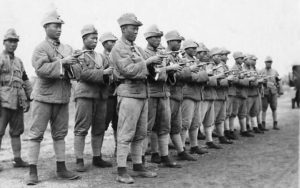Part I
Richard D. L. Fulton

January 1921 saw the commencement of the pursuit of an unidentified beast among the rolling foothills of Appalachia in Adams County, Pennsylvania, a quest that resulted in the local inhabitants doing more damage to themselves than the sought-after creature. It did not take long for the local newspapers to label the efforts to shoot or kill the strange creature as the “gorilla war.”
The story begins with the reported sighting of a “monstrous animal” near Mount Rock on January 20, 1921.
According to The Gettysburg Times, the creature was spotted whilst sitting upon a rock. “When the monstrous animal saw that it was discovered by some Mount Rock citizens, it arose, stretched itself and disappeared into a nearby wood.” The beast was described as a “large gorilla.”
However, on January 21, The Gettysburg Times noted that, in fact, the creature had been reported as having been sighted “for days” leading up to the newspaper’s January 20 coverage of the bizarre episode.
The newspaper went on to report, “When told this story, one Gettysburg citizen said, ‘It is evident that some of my Mount Rock friends are seeing more peculiar visions now than they did before the advent of the Eighteenth Amendment.”
The Eighteenth Amendment, of course, was one of the federal government’s first significant attempts at social engineering through the alteration of the U.S. Constitution, in which the manufacture, transportation, and sale of alcoholic beverages were outlawed in 1920. This was the period of time during which this controversial, and ultimately repealed (via the Twenty-first Amendment in 1933), legislation became not-so-affectionately known as “Prohibition.”
In spite of Prohibition, the sightings continued—the next time by residents in several northern Adams County municipalities.
The day after the newspaper reported the initial story about the sighting of the unknown animal, it appeared, as the publication garnered more information regarding the incident, that there might be more than just alcohol involved. “Thursday afternoon and evening,” The Gettysburg Times reported, “a general chase with the gorilla as the objective was conducted by the residents of Idaville and vicinity.”
The Gettysburg Times reported that the animal had been described as possibly being a gorilla or a kangaroo, adding that the beast “was first seen at Snyder’s Hill between York Springs and Idaville where a number of men failed in a combined attempt to capture or shoot it.”
By 10:00 p.m. on the night of January 20, “50 men gathered on Pike hill near Idaville and again vainly tried to kill the elusive creature,” which The Gettysburg Times reported, “escaped across the snow to Daniels’ Hill near the Adams-Cumberland County line.”
Theories as to how this alleged “gorilla” managed to find its way into Adams County began to be seriously considered. The newspaper reported, “The theory advanced for the animal is that it escaped from a circus train that wrecked several months ago.”
But no record of any circus train wreck in Pennsylvania could be found in any 1921 newspapers published before January 20.
The Gettysburg Times did note that, thus far, the only damage reportedly inflicted by the unknown was the “robbery of a smokehouse.”
The Gettysburg Times reported on January 25 the first casualty suffered as a direct result of the growing panic over the wandering, but as of yet unidentified creature, suggesting the concern had now spread into adjacent York County as well. “Stories of a wandering gorilla caused the shooting of a mule when Abraham Lau, of Franklintown, York County, mistook the animal for the much talked of wild beast.” According to The Gettysburg Times, when Lau spotted what he thought was the much sought-after and alleged gorilla, “He became alarmed and went to the house for the gun [and] shot and badly injured his neighbor’s mule.” It would not be the first local animal to die in the quest.
The Harrisburg Telegraph began carrying coverage of the mystery “gorilla” in Adams County as of the mule-shooting incident, but noted in the newspaper’s January 26 article that the “mule was not seriously injured by the shot.”
On January 27, The Gettysburg Times reported that the “gorilla” had now been sighted near Waynesboro, in Franklin County. Regarding the multicounty hairy desperado, the newspaper reported, “Harry Shindledecker, an employee of the trolley company in Waynesboro, was on his way to work Wednesday morning [January 26]” and spotted the unidentified beast “while passing the baseball grounds.” Shindledecker subsequently arrived at the Waynesboro trolley barn “in an excited condition,” and described the animal as having appeared to have been “about the height of a man.”
The effort to end the alleged gorilla’s reign of imagined terror, now spanning three counties, heated up on January 26 when one local community launched what was described as an “armed posse” in pursuit of the creature in an effort to put an end to the affair once and for all.
Unfortunately, the only end that resulted from the effort was the life of one of the hunting dogs accompanying the impromptu posse.
The Gettysburg Times reported on January 28 that the “gorilla war” began on the night of January 26 when the beast was reportedly seen in an alley in Rouzerville, in Franklin County. “The word was quickly spread and the members of the Rouzervlle deer camp and every one [sic] else that had a rifle soon turned out,” the newspaper reported. “After the mobilization of marksmen was completed, the attackers in battle formation started up the mountain.”
The advance of the “skirmish line” had barely gotten underway when the creature, or at least what was believed to have been the creature, described now by The Gettysburg Times as a “chimpanzee,” was flushed out. The newspaper reported, “Although a number of shots were fired, the chimpanzee kept on bounding toward the thicker brush of the slope.”
The posse, as such, appears to have decided at this point in the attack to send for backup, which was hastily sent forward to bolster the assailants in the effort to capture or kill (most likely kill) the still essentially unidentified animal. The effects of the added firepower were audible in the nearby communities.
“The firing in the mountain was heard in the village and the town was soon in an uproar,” The Gettysburg Times wrote. Some tactical genius among the combatants then decided “to form a great circle around the foothill where the animal was last seen,” the newspaper reported, adding, “Deployed in this fashion the grizzled hunters and young marksmen moved into the woodland.”
In the process of searching the mountainside “halfway to Pen Mar” without any success at spotting the renegade creature, the hunt did result in yet another casualty. “A black dog running through the underbrush paid the death penalty when an excited hunter mistook it for an ape.”
To add insult to injury, not only had the mighty mountain warriors returned empty-handed, but when they gave up the pursuit and returned to Rouzerville, the creature had already beaten them there. “When the hunters returned from the mountains, the reports say the town was in a turmoil,” the newspaper reported, adding that, “… the animal had been seen there while the hunt was on.”
The Gettysburg Times reported that the younger women in town who were out and about when the beast appeared were so terrified that escorts were provided to see that they got off the streets and to their respective homes safely until the “panic” had subsided.
On January 27 or 28, the creature was again reported to have been seen near Monterey by two young men. “As they neared the Monterey golf links, they saw what they thought was a man approaching on all fours,” The Gettysburg Times reported, until the animal “rose on its hind legs and came toward them making gurgling sounds.”


